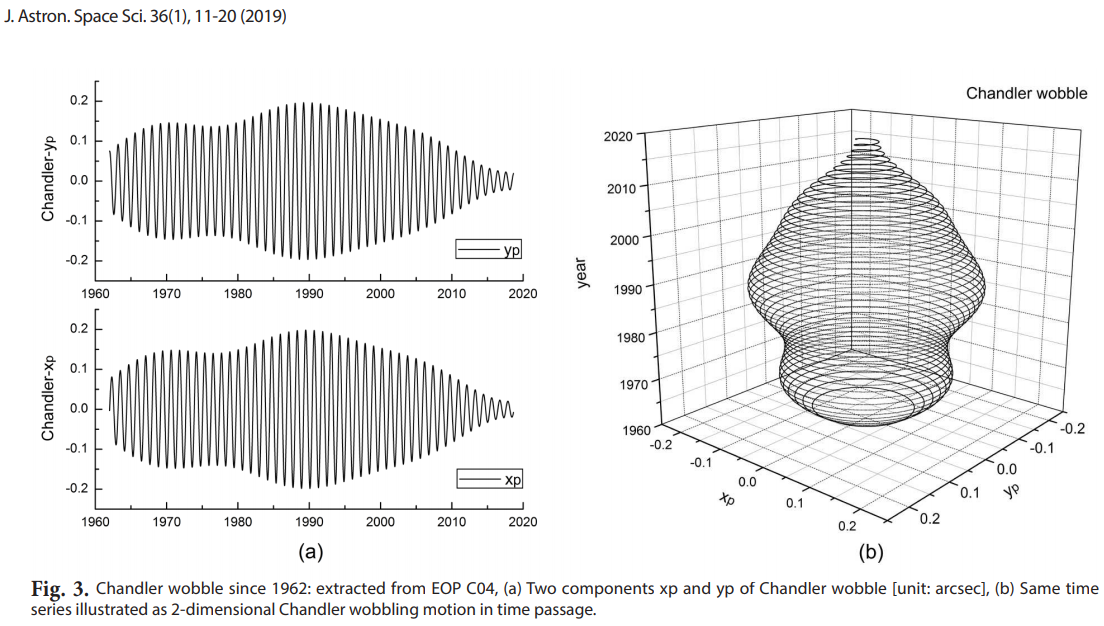In Chapter 13 of the book, we have a description of the mechanism forcing the Chandler Wobble in the Earth’s rotation. As a counter to a recent GeoenergyMath post suggesting there is little consensus behind this mechanism, a recent paper by Na et al provides a foundation to understand how the lunar forcing works.
Chandler wobble and free core nutation are two major modes of perturbation in the Earth rotation. Earth rotation status needs to be known for the coordinate conversion between celestial reference frame and terrestrial reference frame. Due mainly to the tidal torque exerted by the moon and the sun on the Earth’s equatorial bulge, the Earth undergoes precession and nutation.
Na, S.-H. et al. Chandler Wobble and Free Core Nutation: Theory and Features. Journal of Astronomy and Space Sciences 36, 11–20 (2019).
The tidal torque of the earth and sun are sufficient, and the non-spherical bulge is essential to start any kind of precession — as a perfectly-uniform rotating spherical object can’t be influenced by an external torque, explained by symmetry arguments alone.
Na et al estimate the Chandler Wobble cycle from the empirical time-series to be 432.2 days, compared to our estimate of 432.4 days based on the lunar nodal cycle synchronized to a semi-annual cycle.
They continue with a further rationale and formulate a precession matrix that one can apply.
For precession, one may assume the lunar and solar masses as circularly distributed around the Earth like donuts. In fact, the moon and the sun give periodic torques as oscillatory perturbations and lead Earth nutation. By analogy of harmonic oscillator to periodic forces, amplitude of long period nutation is larger than short period one.
Na, S.-H. et al. Chandler Wobble and Free Core Nutation: Theory and Features. Journal of Astronomy and Space Sciences 36, 11–20 (2019).
So the foundation is in place but they have yet to make an association of the ~432 day cycle to the known simultaneous nodal crossing period.
Another finding that they make is the apparent measured decrease in the amplitude of the Chandler wobble over time.

This may be related to the Earth’s spin axis drift over recent years, perhaps revealing a change in the moment of inertia — caused by redistribution of mass such as in glaciers, glacial rebound, and/or mantle convection. Less likely, but perhaps coincidental, could this decrease be related to the QBO anomaly of 2016, which also is synchronized to the nodal crossing cycle?
In any case, it will be interesting if the cycle period remains constant with further reduction in wobble amplitude.
see this as well:
https://www.profolus.com/topics/polar-motion-the-causes-of-spin-axis-drift/
LikeLike
This study correlates the 6.4 year envelope of Chandler Wobble with magma eruptions on Mt. Etna
https://phys.org/news/2019-12-earth-earthquakes-volcanic-eruptions-mount.html
Lambert, S. & Sottili, G. Is there an influence of the pole tide on volcanism? Insights from Mount Etna recent activity. Geophysical Research Letters (2019) doi:10.1029/2019GL085525.
And from earlier in the year, Tamino found this correlation of Chandler Wobble with sea-level rise oscillations at mid-latitudes along the USA east cost:
https://tamino.wordpress.com/2019/01/12/wobbly-sea-level-rise-u-s-east-coast-vi/
LikeLike
Pingback: EGU 2020 Notes | GeoEnergy Math
Click to access Sp16Bell.pdf
LikeLike
Some aspects of a random walk in an energy well (i.e. Ornstein-Uhlenbeck process) applied to the wobble.
Click to access 2001.05965.pdf
LikeLike
https://sci-hub.tw/10.1142/S012918312050117X
International Journal of Modern Physics C
Article Title: Model discrepancy of Earth polar motion using topological data analysis
and convolutional neural network analysis
Author(s): Dongjin Lee, Christopher Bresten, Kookhyoun Youm, Ki-Weon Seo, JaeHun Jung
DOI: 10.1142/S012918312050117X
LikeLike
https://sci-hub.tw/10.1007/978-981-15-2600-8
Krylov S.S., Perepelkin V.V., Filippova A.S. (2020)
Long-Period Lunar Perturbations in Earth Pole Oscillatory Process: Theory and Observations.
In: Jain L., Favorskaya M., Nikitin I., Reviznikov D. (eds) Advances in Theory and Practice of Computational Mechanics. Smart Innovation, Systems and Technologies, vol 173. Springer, Singapore. https://doi.org/10.1007/978-981-15-2600-8_22
No idea if they are saying what drives the frequency, even though Fig 22-2 pins down the 18.6 year period
LikeLike